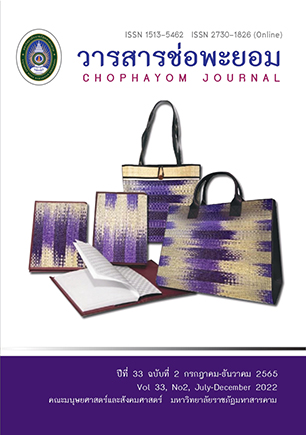New Normal Words: An Analysis of Word Formation Processes of COVID-19 Neologisms
Keywords:
COVID-19, Coronavirus, new words, neologisms, word formation processesAbstract
New words always occur in a language since people have the creativity to develop and form new words. They are often produced for naming newly created things and concepts, or old ideas that have taken on a new cultural context, mainly as a result of historical and social changes (Lin, 2013). Such process of creating new words is called neologism. Nowadays, it could be noticed that there are a number of neologisms coined in reference to the global pandemic of COVID-19. Therefore, this study highlighted neologisms as a linguistic phenomenon that has been aroused by the COVID-19 pandemic. The aim of the study is to investigate the common types of word formation processes involved in creating COVID-19-related neologisms based on the framework proposed by O'Grady et al. (2005) and Yule (2006). The research data were collected from lists of words related to COVID-19 selected from five different websites, published from March to October 2020. The results revealed that blending, compounding, and multiple processes are the three most frequently employed processes in creating COVID-19-related neologisms. These three processes are the most productive ways for creating COVID-19-related words mainly because a newly derived word is meaningful consisting of two or more words combined together and its meaning can be deducible from its constituents. Moreover, most of the new words have a component that is related to a pandemic situation, so they are able to connect to people's lives during the COVID-19 pandemic. Overall, the study could illustrate how language adapts to new environmental conditions by creating new words using already existing words. It also established that the rise of the coronavirus pandemic has accounted for the recent increase of numerous neologisms in English. Keywords: COVID-19, Coronavirus, new words, neologisms, word formation processes
References
Aduda, K. (2013). A relevance theoretical analysis of dholuo neologism [Unpublished master’s thesis]. University of Nairobi.
Al-Azzawi, Q. O., & Haleem, H. A. (2021). “ Do you speak Corona?”:Hashtags and Neologisms since the COVID-19 Pandemic
Outbreak. International Journal of Linguistics, Literature and Translation, 4(4), 113-122.
Alyeksyeyeva, I. O., Chaiuk, T. A., & Galitska, E. A. (2020). Corona speak as key to coronaculture: Studying new cultural prac
tices through neologisms. International Journal of English Linguistics, 10(6), 202-212.
Asif, M., Zhiyong, D., Iram, A., & Nisar, M. (2021). Linguistic analysis of neologism related to coronavirus (COVID-19). Social Sciences & Humanities Open, 4(1), 100201.
Cook, C. P. (2010). Exploiting linguistic knowledge to infer properties of neologisms. Toronto: University of Toronto.
Decerf, B., Ferreira, F. H., Mahler, D. G., & Sterck, O. (2021). Lives and livelihoods: estimates of the global mortality and poverty effects of the Covid-19 pandemic. World Development, 146, 105561.
Dika, R. D. (2021). Word formation analysis of car terminologies in Ford v Ferrari (Doctoral dissertation, UNIVERSITAS SANATA DHARMA YOGYAKARTA).
Galperin, I.R. (1981). Stylistics of the English Language. Moscow: Vysshaya Shkola.
Huddleston, R. D. (2002). The Cambridge grammar of the English language. Cambridge: Cambridge University Press.
Ibrahim, E. R., Kadhim, S. A. H., Mayuuf, H. H., & Haleem, H. A. (2020). A sociolinguistic approach to linguistic changes since the
COVID-19 pandemic outbreak. Multicultural Education, 6(4), 122-128.
Kemmer, S. (2006). Schemas and lexical blends. USA & Germany: Rice University and Max Planck Institute for Evolutionary Anthropology.
Kubova, K. (2009). Neologisms in English. Masaryk: Masaryk University Press.
Lin, M. C. (2013). A new perspective on the creation of neologisms. Acta Linguistica Asiatica, 3(1), 47-60.
Mair, C. (2006). Twentieth-century English: History, variation and standardization. Cambridge: Cambridge University Press.
Mweri, J. (2021). Corona Virus Disease (COVID-19) effects on language use: An analysis of neologisms. Linguistics and Literature
Studies, 9(1), 36-47.
Newmark, P. (1988). A textbook of translation. New York: Prentice Hall.
O'Grady, W., Archibald, J., Aronoff, M., & Rees-Miller, J. (2005). Contemporary linguistics: An introduction. New York: Bedford/St. Martin's.
Plag, I. (2003). Word-formation in English. New York: Cambridge University Press.
Reichelt, M. (2020). Elephant in the zoom: Coronavirus-related language goes viral. Retrieved from https://www.toledoblade.com/a-e/culture/2020/05/31/corona-speak-Virus-related-language-goes-viral/stories/20200531002.
Rets, I. (2014). Studying the new vocabulary of the Dutch language in the context of globalization. Philological sciences. Theoretical and practical questions, 6(4), 149.
Yule, G. (2006). The Study of Language. Cambridge: Cambridge University Press.
Downloads
Published
How to Cite
Issue
Section
License
Copyright (c) 2022 Chophayom Journal

This work is licensed under a Creative Commons Attribution-NonCommercial-NoDerivatives 4.0 International License.






